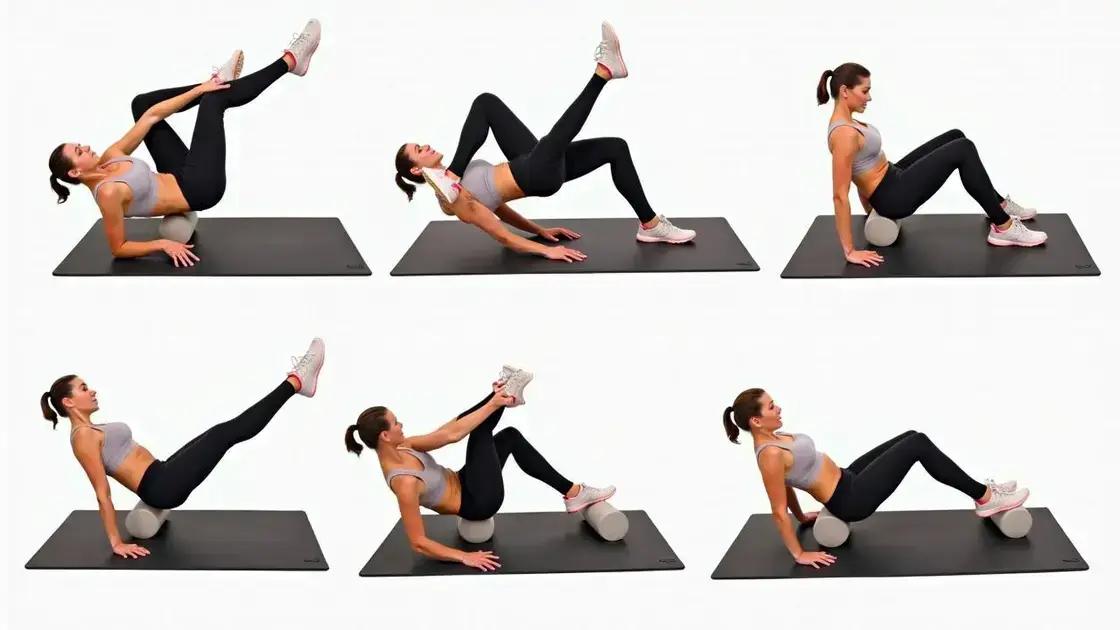Foam rolling is a key technique for muscle recovery, offering benefits such as reduced soreness, improved blood circulation, and enhanced flexibility. For optimal results, foam roll two to three times a week after workouts, focusing on specific tight areas while avoiding common mistakes like rolling too fast or neglecting hydration.
Foam rolling is an essential tool for anyone seeking muscle recovery. This self-myofascial release technique helps to relieve muscle tightness, improve flexibility, and enhance overall recovery after workouts. If you’re asking how to use foam rolling for muscle recovery, this article will guide you through the benefits, best techniques, and common mistakes to avoid. Embrace foam rolling as part of your fitness routine and discover how it can significantly enhance your recovery process.
Benefits of Foam Rolling for Muscle Recovery

Foam rolling provides several benefits for muscle recovery, making it an essential part of a fitness routine. This technique helps reduce muscle soreness after workouts, enabling athletes and fitness enthusiasts to recover faster.
Improves Blood Circulation
Foam rolling improves blood flow to tight muscles. As you apply pressure, it helps release tension and encourages increased circulation, which aids in delivering nutrients to the muscles and expelling waste products.
Reduces Muscle Tension
This practice helps to release knots and tight spots in the muscles. By rolling over tight areas, you effectively elongate and relax muscle fibers, which reduces overall tension and improves flexibility.
Enhances Flexibility and Range of Motion
Regular foam rolling can lead to improved flexibility and a greater range of motion, which is essential for preventing injuries. Increased flexibility allows for better performance in physical activities.
Promotes Faster Recovery
Foam rolling can help decrease delayed onset muscle soreness (DOMS), often experienced after intense workouts. By incorporating foam rolling into your recovery routine, you can feel rejuvenated and ready for your next training session sooner.
Cost-Effective Recovery Tool
One of the best things about foam rolling is that it is an inexpensive way to support recovery. Investing in a foam roller is significantly more affordable than frequent visits to massage therapists.
Best Techniques for Foam Rolling

Using foam rolling effectively involves employing various techniques to target different muscle groups. Here are some of the best techniques for foam rolling:
1. Target Specific Muscle Groups
Focus on areas that feel particularly tight. For example, rolling out your quads can ease tightness after leg workouts, while spending time on the IT band can relieve discomfort in the outer thigh.
2. Use Your Body Weight
Your body weight is key to effective foam rolling. Adjust the pressure based on your comfort level. Apply more weight on tighter spots, and less on areas that are too sore. Always listen to your body!
3. Roll Slowly
When rolling, maintain a slow and controlled pace. Move at about one inch per second. This gives your muscles time to respond to the pressure and reduces the risk of injury.
4. Hold on Tight Areas
If you find a knot, hold the foam roller directly on that spot for 20-30 seconds. This technique, known as trigger point release, helps the muscle to relax and can alleviate soreness.
5. Use Different Angles
Change your angle of approach to reach different muscle fibers. Rolling at various angles can enhance the overall effectiveness of your foam rolling session.
6. Combine with Stretching
For the best results, combine foam rolling with stretching. After rolling, perform static stretches to help maximize flexibility and promote greater muscle recovery.
How Often Should You Foam Roll?

Knowing how often to foam roll can greatly enhance your muscle recovery process. Here are some guidelines on frequency:
1. Post-Workout Routine
It is best to foam roll immediately after your workout. This practice helps release any tightness built up during exercise and promotes faster recovery.
2. Frequency During the Week
For most individuals, two to three times per week is ideal. If you are training intensely, consider rolling every day, especially after tough workouts.
3. Duration of Each Session
Each session should last around 10 to 20 minutes, focusing on major muscle groups or areas that feel tight. Spend additional time on areas that require extra attention.
4. Listen to Your Body
Always pay attention to how your body feels. If you experience discomfort or soreness that lasts more than a few hours, reduce the frequency or pressure.
5. Adjust Based on Activity Level
Your frequency may depend on your activity level. If you are less active, rolling once a week may be sufficient. More active individuals may need to stick to the two to three times per week guideline.
Common Mistakes to Avoid When Foam Rolling

Avoiding common mistakes when foam rolling can enhance its effectiveness and prevent injury. Here are some key mistakes to watch out for:
1. Rolling Too Fast
Many people make the mistake of rolling too quickly. This can lead to ineffective muscle release. Instead, aim to roll slowly, allowing pressure to gradually release tension.
2. Not Focusing on Tight Areas
Foam rolling should target specific tight spots rather than rolling randomly. Identify areas of discomfort and spend more time on them for better results.
3. Using Improper Body Mechanics
Using incorrect form can lead to strain. Make sure to maintain a stable position and use your arms and legs to control your movement on the roller.
4. Neglecting Hydration
Foam rolling can release toxins, so it’s essential to stay hydrated before and after your session. This helps your body flush out these toxins effectively.
5. Skipping Areas
Don’t ignore major muscle groups like the glutes, hamstrings, and back. Each area is important for overall muscle recovery, so make sure to cover all bases.
In Summary: Mastering Foam Rolling for Optimal Muscle Recovery
Foam rolling is a crucial aspect of muscle recovery that can enhance your overall fitness routine. By understanding the benefits, employing the best techniques, and knowing how often to roll, you can maximize the effects of this practice.
Avoiding common mistakes will further ensure that you are foam rolling safely and effectively. Incorporating these strategies into your routine can lead to improved performance, reduced soreness, and quicker recovery times.
With consistency and proper technique, foam rolling can significantly contribute to your athletic success and overall well-being.
FAQ – Frequently Asked Questions about Foam Rolling
What are the benefits of foam rolling for muscle recovery?
Foam rolling helps reduce muscle soreness, improves blood circulation, and enhances flexibility, promoting faster recovery after workouts.
How often should I foam roll?
It’s recommended to foam roll two to three times a week, especially after workouts. For intense training, consider rolling every day.
What are the best techniques for foam rolling?
Focus on specific muscle groups, use your body weight, roll slowly, hold on tight areas, change angles, and combine with stretching.
Are there common mistakes to avoid when foam rolling?
Yes, avoid rolling too fast, not focusing on tight areas, using improper body mechanics, neglecting hydration, and skipping major muscle groups.
Can foam rolling help with flexibility?
Absolutely! Foam rolling can improve flexibility and increase your range of motion, which is key for preventing injuries.
Is foam rolling safe for everyone?
While foam rolling is generally safe for most people, those with injuries or specific medical conditions should consult a healthcare professional before starting.












